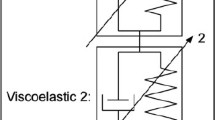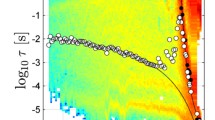Abstract
The time-dependent behavior of bulk polymer film and wire with polymer insulation is studied using indentation. The indenter is displaced into the material at a constant rate and then held at a fixed indentation depth to monitor load relaxation. A finite element simulation of the experiment is performed; this analysis is parameterized in terms of the unknown shear compliance modeled as a Prony series. An optimization method is then presented to determine the unknown material parameters by minimizing the RMS error between the model and the experimental data. The method is demonstrated with poly (vinyl chloride) (PVC) films after thermal aging and pristine polyethylene sheet; excellent agreement between the model and the data is demonstrated. The method is also demonstrated to successfully characterize the material properties for the compression of a wire with PVC insulation; the resulting properties are then shown to adequately predict the crossed-cylinder indentation behavior of the same wire using a 3D finite element model. The chief benefit of the method is that an analytical solution method is not required for its implementation; as such, the optimization approach can be readily applied to the determination of material properties from arbitrarily complex experimental geometries.















Similar content being viewed by others
Notes
The film is described as “Clear PVC, Type 1” and was purchased from McMaster-Carr, item 87875K17. The polyethylene was also purchased from McMaster-Carr as a 305 mm (12 in.) square sheet, item 875K121.
For the PVC films with various levels of thermal aging, the displacement necessary to reach the desired load decreased with increasing aging due to increasing specimen stiffness. As the time for the load portion was maintained constant (2 s), this means that the rate of indentation for the set of cases varies from approximately 8–28 μm/s. One alternate approach would be to use a constant indentation rate but this would necessitate varying the time for the load portion. Another approach would be to use the same loading time but this would lead to variations in the final load among the cases. In this study, we judged that it was preferable to use a constant load portion time with a fixed final load value, accepting that this introduces a rate variation between the various cases.
The core consists of stranded wire and should have stiffness properties lower than bulk copper. Simulations were performed using 20–100% of the modulus value; little if any difference was noted in terms of the polymer properties that optimize a given set of indentation data. This is likely due to the fact that the wire is several orders of magnitude stiffer than the polymer insulation; as such, any variation in the conductor properties does not lead to sufficient additional deformation to significantly alter the overall findings.
As specimen stiffness increases, it becomes increasingly difficult to locate the indenter to the precise initial contact point. In such cases, it takes some time during the load portion for proper contact to occur between the indenter and the film specimen. During this time, the force values remain relatively low and do not accurately reflect the specimen stiffness. For such specimens (typically after 3 weeks or more of thermal aging), the moment of proper contact is assessed after the test, the data suitably corrected, and that corrected data is presented here. The method of correction is explained in Appendix.
References
Ferry JD (1980) Viscoelastic properties of polymers. Wiley, New York.
Oliver WC, Pharr GM (1992) An improved technique for determining hardness and elastic modulus using load and displacement sensing experiments. J Mater Res 7(6):1564–1583.
Tang KC, Arnell RD (1999) Determination of coating mechanical properties using spherical indenters. Thin Solid Films 355-356:263–269.
Fischer-Cripps AC (2004) A simple phenomenological approach to nanoindentation creep. Mater Sci Eng A 385:74–82.
Lu H, Wang B, Ma J, Huang G, Viswanathan H (2003) Measurement of creep compliance of solid polymers by nanoindentation. Mech Time-Depend Mater 7:189-207.
Johnson KL (1985) Contact mechanics. Cambridge University Press, Cambridge.
Lee EH, Radok JRM (1960) The contact problem for viscoelastic bodies. J Appl Mech 27:438–444.
Ting TCT (1966) The contact stresses between a rigid indenter a viscoelastic half-space. J Appl Mech 33:845–854.
Yang WH (1966) The contact problem for viscoelastic bodies. J Appl Mech 33:395–401.
Cheng Y-T, Cheng C-M, Ni W (2006) Methods of obtaining instantaneous modulus of viscoelastic solids using displacement-controlled instrumented indentation with axisymmetric indenters of arbitrary smooth profiles. Mater Sci Eng A 423:2–7.
Cheng Y-T, Ni W, Cheng C-M (2005) Determining the instantaneous modulus of viscoelastic solids using instrumented indentation measurements. J Mater Res 20(11):3061–3071.
Beake B (2006) Modelling indentation creep of polymers: a phenomenological approach. J Phys D Appl Phys 39:4478–4485.
Cheng Y-T, Ni W, Cheng C-M (2006) Nonlinear analysis of oscillatory indentation in elastic and viscoelastic solids. Phys Rev Lett PRL 97(075506):1–4.
Huang G, Wang B, Lu H (2004) Measurements of viscoelastic functions in frequency-domain using nanoindentation. Mech Time-Depend Mater 8:345–364.
Chakravartula A, Komvopoulos K (2006) Viscoelastic properties of polymer surfaces investigated by nanoscale dynamic mechanical analysis. Appl Phys Lett PRL 88(131901):1–3.
Odegard GM, Gates TS, Herring HM (2005) Characterization of viscoelastic properties of polymeric materials through nanoindentation. Exp Mech 45(2):130–136.
Kim SH, Lee BW, Choi Y, Kwon D (2006) Quantitative determination of contact depth during spherical indentation of metallic materials—A FEM study. Mater Sci Eng A 415:59–65.
Gonda V, den Toonder J, Beijer J, Zhang GQ, Ernst LJ (2005) Finite thickness influence on spherical and conical indentation on viscoelastic thin polymer film. J Electron Packag 125:33–37.
Brinson LC, Shen H, Thillaiyan R, Shull K, Mason T, Bradshaw RD, Resapu RR, Nagendran KB (2006) Finite element modeling of the indentation response of PVC film and wire: Material property optimization and predictions for 3D wire models (August 15, 2006 report to the airworthiness assurance center of excellence/Federal Aviation Administration under contract 437-25-55/DTFA03-03-F-IA055). Northwestern University/University of Louisville.
Brinson LC, Thillaiyan R, Shen H, Zhang H, Shull KR, Mason TO, Bradshaw RD, Nagendran KB, Resapu RR, Mann AD, Payne ME (2007) Aging of Polymeric Insulation In Aircraft Wiring: Mechanical And Electrical Property Characterization and Correlation (April 21, 2007 report to the Airworthiness Assurance Center of Excellence/Federal Aviation Administration under contract 437-25-55/DTFA03-03-F-IA055). Northwestern University/University of Louisville.
MIL-DTL-16878/1C, Wire, Electrical, Polyvinyl Chloride (PVC) Insulated, 105 Deg. C, 600 Volts (Not For Navy Shipboard Use) (August 11, 2000). 2000.
Denny B, Material Testing Research and Indenter Equipment Modifications for Determining Aging of Wires (Cables) in Aircraft (DOT/FAA/AR-04/17). 2004, US Department of Transportation, Federal Aviation Administration: Washington, DC.
Mase GE, Mase GT (1999) Continuum mechanics for engineers, second edition. CRC Press, Boca Raton, FL.
Acknowledgments
The authors would like to acknowledge the support for this work provided by the Airworthiness Assurance Center of Excellence and the Federal Aviation Administration under contract number 437-25-55/ DTFA03-03-F-IA055. The authors would also like to acknowledge the contract co-PIs L. C. Brinson, K. R. Shull and T. O. Mason of Northwestern University for technical input during the development of this work. The authors would finally like to acknowledge Dr. Hui Shen, who performed the ABAQUS 3D model simulation using the viscoelastic properties developed during this study.
Author information
Authors and Affiliations
Corresponding author
Appendix
Appendix
Appendix—Correction of Raw Data
Before performing material property optimization for the indentation data for PVC films, corrections to the experimental data set must be performed in certain cases. This is typically true for materials at long aging times that are relatively stiff. In these cases, it is difficult to precisely define the moment of zero indentation during the experimental setup. As such, there can be a region of the data in which indenter displacement occurs but the force changes only slightly; after a sufficient amount of displacement, the force increases rapidly as expected. If the finite element optimization method is applied to the data as collected, the obtained model results often will not fit the data very well. An example of this phenomenon is shown in Fig. 16 for the load portion of PVC film aged for 3 weeks at 100°C. Clearly, minimal contact between the indenter and the film was achieved for the first 0.6–0.8 s of the experiment.
In order to correct this feature, the classical film indentation model relationship between indenter force F and indentation depth δ is used [equation (6)]. This relationship is parabolic in nature and is valid for any value of δ; as such, this expression can be differentiated to find:
This equation describes a line that has a value of 0 when the indentation depth δ is 0. For the experiment using the DMA, the indenter is moved at a constant rate. Calling this constant rate as v = dδ/dt, the equation above can be rewritten in a more useful form in terms of time using the chain rule as:
where the substitution δ = vt has been made recognizing the constant indentation rate. Thus, the rate of change in indentation force with time (dF/dt) is linear and is equal to 0 at the moment the indentation begins (t = 0).
Based on this result, the time derivative of the force (dF/dt) is approximated as the ratio of the change in force (ΔF) for each step to the change in time (Δt) for each step and considered. The resulting data for ΔF/Δt for the PVC film aged 3 weeks is shown in Fig. 17. The data clearly becomes linear only in the later part of the experiment; a straight line is passed through the linear portion as shown and an effective start point of the experiment is identified. The values of time, force and indentation depth at this point are t S = 0.80 s, F S = −0.0701 N and δ S = 0.007 mm, respectively. The data is then adjusted to account for the new effective starting point as:
where the values with the “new” subscript value are used in the ANSYS optimization. The ANSYS fit that is obtained for this data is shown in Fig. 18; it is clearly more representative of the data set. Modifications in this manner were performed for the PVC film data aged for 3, 4, 5 and 6 weeks. The PVC film data aged for shorter periods did not exhibit such difficulties and was used as is.
Rights and permissions
About this article
Cite this article
Resapu, R.R., Nagendran, K.B. & Bradshaw, R.D. A Finite Element Method for the Determination of Optimal Viscoelastic Material Properties from Indentation Tests of Polymer Film and Wire with Polymer Insulation. Exp Mech 48, 713–729 (2008). https://doi.org/10.1007/s11340-007-9109-x
Received:
Accepted:
Published:
Issue Date:
DOI: https://doi.org/10.1007/s11340-007-9109-x







